Métis buffalo hunt
Métis buffalo hunting began on the North American plains in the late 1700s[1] and continued until 1878.[2] The great buffalo hunts were subsistence, political, economic, and military operations[3] for Métis families and communities living in the region.[4] At the height of the buffalo hunt era, there were two major hunt seasons: summer and autumn. These hunts were highly organized, with an elected council to lead the expedition.[5] This made sure the process was fair and all families were well-fed and provided for throughout the year.
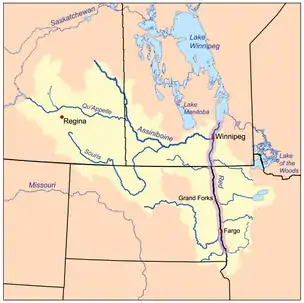
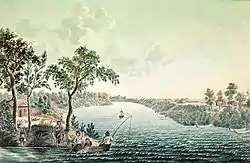

Nomenclature
Though there are no buffalo species that are indigenous to the Americas, the Michif term for bison is lii bufloo.[6] Bison are not a species of the Bubalina subtribe that includes all of the true buffalo species, but American bison have been known as buffalo since 1616 when Samuel de Champlain applied the term buffalo (buffles in French) to the species, based on skins and drawings shown to him by members of the Nipissing First Nation who had traded with other First Nations that hunted them.[7] There is a very closely related bison species indigenous to Europe, called the European bison (also known as wisent or the European wood bison), however, it's very likely that the early European explorers had never seen nor heard of a European bison as they were essentially extirpated from Western Europe during the Middle Ages.[8]
Early history
Métis buffalo hunting began in the late 18th century.[9] Trading companies working on the plains sought out food items that could last their traders on long trips; pemmican can be stored for long periods of time without spoiling, which made it an ideal product. The Métis commercialized their hunts to engage in trade and supply pemmican to these companies.[9] In these early days buffalo herds still lived in close proximity to the communities, so Métis families in the Red River region could conduct their hunting and trading individually without needing to travel.[10] As settler and Métis populations grew, the buffalo moved further away and hunts increasingly grew in size and scale to keep up with demand and provide for their expanding communities.[10] These changes brought a new organization to the buffalo hunts, with Métis families forming parties to travel in safety.[10]
Buffalo hunts
The Metis buffalo hunts were held at two times during a year by the Métis of the Red River settlements during the North American fur trade. The buffalo hunt out of Red River region had three major parties: the Pembina Métis, the Métis of St. Boniface, also known as the Main River party, and the St. Francois Xavier Métis.[11] The Métis of St. Boniface, situated on the banks of the Red River of the North in what is now the city of Winnipeg, Manitoba, Canada, formed the largest contingent of these hunts; composed of a summer hunt and an autumn hunt. By the 1830s, every major hunt had a common form and governance structure.[12] The largest-scale buffalo hunts began a decade later.[12] For the summer hunts, the three parties would gather at Pembina to organize before continuing on to the buffalo hunting grounds.[10]
All members of the family participated in the hunt in some way; the faster the buffalo meat could be processed and preserved meant less potential for spoilage as a result of changing weather conditions.[12] Men were typically the hunters, while women were responsible for maintaining the camps, preparing and preserving the buffalo meat.[11] A successful hunt could bring in thousands of buffalo.[12]
Summer hunts
The summer buffalo hunt, otherwise known as the dried meat hunt, traditionally occurred from June to late July or early August. When the season began, the Métis, after sowing their fields in the spring, set out with their wives and children leaving a few behind to take care of the crops.[13] The warmer temperatures made this season ideal for producing dried meat, pemmican, and buffalo tongue, which the Métis would trade most often with the Hudson Bay company.[10]
In 1840 the settlement had over 4,800 people of which 1,630 took part in the summer hunt[14] and headed south on the prairie. Often harassed by the Sioux, the Métis from the various settlements of Red River travelled in large groups for protection.[15] Another smaller portion of the population would join the York boat brigades including the Portage La Loche Brigade heading north.
The buffalo hunts provided the Métis with an impressive organizational structure and by 1820 was a permanent feature of life for all individuals on or near the Red River and other Métis communities.
— Louis Riel Institute[16]
In 1879 the hunters on the prairies of Canada reported that only a few buffalo were left of the great herds and two years later the last of the buffalo herds in the Montana Territory were also gone.[2]
Paul Kane, an Irish-born Canadian painter, witnessed and participated in the Métis buffalo hunt of 1846.[17] Several of his paintings depict scenes of this hunt in the Sioux lands of the Dakota Territory in the United States of America.
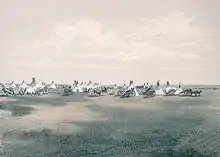

The summer hunts increased in size from 540 Red River carts in the 1820 summer hunt, 689 carts in 1825, 820 in 1830, 970 in 1835 and 1210 carts in 1840.[14]
In 1823 William H. Keating described a group of buffalo hunters he encountered at Pembina by the Red River. The group had a total of 300 people and consisted of 115 Red River carts and at least 200 horses. These men, he wrote, are Gens libres or freemen and are not Engagés or servants who are employed by the Hudson's Bay Company. The Métis among them are called Bois brulés.[18]
All of them have a blue capote with a hood, which they use only in bad weather; the Capote is secured round their waist by a military sash; they wear a shirt of calico or painted muslin, moccasins and leather leggings fastened round the leg by garters ornamented with beads,&c. The Bois brulés often dispense with a hat; when they have one, it is generally variegated in the Indian manner, with feathers, gilt lace, and other tawdry ornaments.
— William Keating 1824[18]
Their horses are from the southern prairies or from New Spain having been traded and re-traded until they come into their possession.[18] The buffalo runner, a horse bred for speed and intelligence, was used principally for the hunt. Often its saddle and trappings were decorated with beads and porcupine quills[19] and for the hunt its mane and tail were intertwined with multicolored ribbons.[13]
The word given, the horsemen start in a body, loading and firing on horseback, and leaving the dead animals to be identified after the run is over. The kind of horse used is called a "buffalo runner," and is very valuable. A good one will cost from 50 to 70 pounds sterling. The sagacity of the animal is chiefly shewn in bringing his rider alongside the retreating buffalo, and in avoiding the numerous pitfalls abounding on the prairie. The most treacherous of the latter are the badger holes. Considering the bold nature of the sport, remarkably few accidents occur. The hunters enter the herd with their mouths full of bullets. A handful of gunpowder is let fall from their "powder horns," a bullet is dropped from the mouth into the muzzle, a tap with the butt end of the firelock on the saddle causes the salivated bullet to adhere to the powder during the second necessary to depress the barrel, when the discharge is instantly effected without bringing the gun to the shoulder.
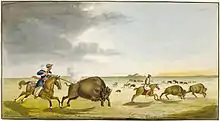
Leaving Fort Garry on June 15, 1840 were 1210 Red river carts, 620 hunters, 650 women, 360 boys and girls, 403 buffalo runners (horses), 655 cart horses, 586 draught oxen and 542 dogs in the hunting expedition. In three days they reached their rendezvous at Pembina 60 miles (97 km) to the south and set up a tent city.
The carts were set up to form a solid defensive circle with forks facing out. Within the circle the tents were set up in rows on one side and, facing the tents, the animals on the other side. The animals are kept outside when deemed safe.[14]
At Pembina a count was taken of those taking part (1,630 in 1840), a general council was held and leaders were chosen. Ten captains were chosen in 1840 Jean Baptiste Wilkie[21] being chosen as the war chief and the president of the camp. Each captain had ten soldiers under them. Ten guides were also chosen. A smaller council of the leaders was also held to lay down the rules or laws of the hunt.[14]
Leaving Pembina on June 21 the group travelled 150 miles (240 km) southwest reaching the Sheyenne River nine days later. On July 3, sighting buffalo 100 miles (160 km) further, 400 mounted hunters killed about 1,000.[14] In carts the women then arrived to cut up the meat and haul the pieces back to the camp. It took the women several days to prepare the dried meat. The camp then moved on to another site.[13] That year the hunting group returned to Fort Garry with about 900 pounds (410 kg) of buffalo meat per cart or 1,089,000 pounds (494,000 kg) in all[14] or the dried meat of between 10,000 and 10,500 buffalo.
In 1849 there were two summer hunts from the Red River. The St. Francois Xavier (White Horse Plain) group alone numbered 700 Métis, 200 Indians, 603 carts, 600 horses, 200 oxen and 400 dogs.[22]
Isaac Stevens of the US Pacific Railroad Surveys (1853-1854) who camped near the Red River hunters near Devil's Lake, North Dakota in 1853 (July 16) provided a description of the 1853 summer hunt.[21] The hunt was led by Jean Baptiste Wilkie and had 1,300 people, 1,200 animals and 824 carts. The camp consisted of 104 tepees, most shared by two families, arranged within a circle of carts which covered in skins provided additional sleeping quarters. The animals are driven into the circle at night and 36 men stand guard on the sleeping camp.[21]
They are generally accompanied by their priests, and attend strictly to their devotions, having exercises every Sabbath, on which day they neither march nor hunt. Their municipal government is of a parochial character, being divided into five parishes, each one being presided over by an officer called the captain of the parish. These captains of the parish retain their authority while in the settlement. On departing for the hunt they select a man from the whole number, who is styled governor of the hunt, who takes charge of the party, regulates its movement, acts as referee in all cases where any differences arise between the members in regard to game or other matters, and takes command in case of difficulty with the Indians.
Six days later Stevens group encountered another hunting group led by Urbain Delorme of St. Francois Xavier. Delorme led this group, that averaged 500 carts, for 25 consecutive years.[24]
Autumn hunt
The autumn hunt started in September and ended in late October or early November.[20] When the hunters returned about half of the pemmican and dried meat was kept for their winter provision and the rest sold to the Hudson's Bay Company at Fort Garry. The hunters also had some fresh meat (preserved by the cold).[20] This hunt was smaller than the summer hunt as many of the hunters, the hivernants or winterers, who had taken part of the summer hunt leave the settlements to pass the winter on the Prairies with their families to trap and hunt.[14][25] The early fall was also the harvest season, so more family members were needed to remain at home to farm (Ens).
Some of the products of these hunts, especially prime buffalo robes taken from November to February,[25] also found their way by the Red River Trails to the American Fur Company at Fort Snelling and exchanged for dry goods such as sugar, tea and ammunition.[21]
Sioux conflicts
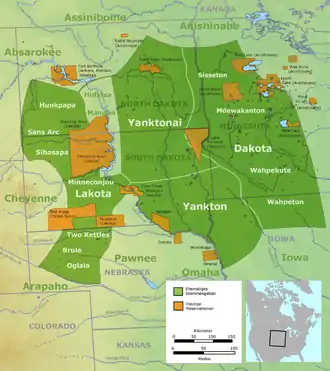
During the 1840s and 1850s the Métis followed the buffalo herds further into the Dakota Territory bringing them into conflict with the Sioux.[15] Cuthbert Grant, an early captain of the buffalo hunt, negotiated a treaty in 1844.[26] Another treaty was concluded in 1851 and another in 1854 but Métis hunting groups were still being attacked by the Sioux.[15] Jean Baptiste Wilkie, the leader of the 1840, 1848 and the 1853 summer hunt, helped negotiate a peace treaty in 1859 and another in 1861 between the Métis, Chippewa and the Sioux (Dakota) to set hunting boundary lines.[21] These peace overtures did not last and conflict continued between the Métis and the various Sioux groups even after the Dakota War of 1862.[15]
In the 1848 summer hunt the hunting group, made up of 800 Métis led by Jean Baptiste Wilkie and 200 Chippewa led by Chief Old Red Bear and over 1,000 carts, met the Sioux in the Battle of O'Brien's Coulée near Olga, North Dakota.[21]
Between July 13 and 14, 1851 a large band of Sioux attacked the St. François Xavier hunting camp in North Dakota on the Grand Coteau du Missouri resulting in the last major battle, the Battle of Grand Coteau (North Dakota), fought between the two groups. The Métis were victorious.[15][27]
The St. Boniface group, accompanied by Father Albert Lacombe, made rendezvous with the Pembina group (June 16) then travelled west to meet the St. François Xavier group (June 19). There were 1,300 people, 1,100 carts and 318 hunters in the combined groups. The groups hunted separately but planned to unite against any threat from the Sioux. They divided into 3 groups about 20 miles (32 km) to 30 miles (48 km) from each other moving in the same direction.
The St. François Xavier (White Horse Plain) group led by Jean Baptiste Falcon, son of Pierre Falcon,[28] and accompanied by its missionary, Father Louis-François Richer Laflèche, numbered 200 carts and 67 hunters plus women and children. In North Dakota on the Grand Coteau of the Missouri on July 12 the scouts of St. François Xavier spotted a large band of Sioux. The five scouts riding back to warn the camp met with a party of 20 Sioux who surrounded them. Two made a run for it under fire but 3 were kept as captives. Two would escape the next day and one killed. On Sunday July 13 the camp was attacked by the Sioux. Lafleche dressed only in a black cassock, white surplice, and stole, directed with the camp commander Jean Baptiste Falcon a miraculous defence against the 2,000 Sioux combatants holding up a crucifix during the battle. After a siege of two days (July 13 and 14) the Sioux withdrew convinced that the Great Spirit protected the Métis.[27][29][30]
Present at the Battle of Grand Coteau, fighting by their father's side, were 17-year-old Isadore Dumont who died at the Battle of Duck Lake 34 years later and 13-year-old Gabriel Dumont who commanded the Métis forces in the North-West Rebellion of 1885.[31]
Hunt governance
To ensure their success, the buffalo hunts had a set of leaders and other positions such as scouts, soldiers, and lookouts. Each hunt had a chief and council that would be elected amongst the families of the three Métis hunting brigades.[12] At the rendez-vous at Pembina, a count was taken of those taking part (In 1840, the number was 1,630). There would then be a vote by popular assembly, where the heads of major Métis families would select the principal hunt chief and 10 to 12 councillors, or hunt captains.[12] Each captain had ten soldiers under them. Ten guides were also chosen. A smaller council of the leaders was also held to lay down the rules or laws of the hunt.[14] The chief and council was a decentralized and non-coercive government with limited authority; if there was any decision that went beyond the scope of authority given to them, hunt law required that they consult with the heads of households.[12] The Métis believe in self-ownership while also being community and kin-focussed, so this style of leadership allowed for both familial independence and collective organization.[12]
Laws of the buffalo hunt
In 1840, the following hunt rules were put in place to ensure no hunter would act greedily or harm the other members of the brigade in any way.[14]
- No buffalo to be run on the Sabbath-Day.
- No party to fork off, lag behind, or go before, without permission.
- No person or party to run buffalo before the general order.
- Every captain with his men, in turn, to patrol the camp, and keep guard.
- For the first trespass against these laws, the offender to have his saddle and bridle cut up.
- For the second offence, the coat to be taken off the offender's back, and be cut up.
- For the third offence, the offender to be flogged.
- Any person convicted of theft, even to the value of a sinew, to be brought to the middle of the camp, and the crier to call out his or her name three times, adding the word "Thief", at each time.
This leadership and legal structure evolved to become part of a system of self-government for the Métis communities.[32] For example, in 1873 the Southbranch settlements organized a form of local government, under Gabriel Dumont, based on the laws of the buffalo hunt.[33][34]
Egalitarian practices during the hunt
The Laws of the Buffalo Hunt allowed for a structured and regulated approach to the hunt. These laws were targeted at behaviours that could seriously affect the hunt for all members, such as people opportunistically hunting bison ahead of the camp that could result in scaring the herds, the herds running away, and making the hunt more difficult for the whole party.[35] These laws also reinforced the communal nature of the hunts and the egalitarian values of the Métis society. This included communal sharing of the animals killed so that every family would receive enough meat to support itself, regardless of how many animals were killed by any one person.[36] In addition, the hunt chief would make at least one free pass through the herd, and any animal that he killed was to be given to the old and sick who were unable to hunt for themselves.[37] The practices ensured that there was an equal interest in the success of the hunt by enforcing equity among families, and recognizing both familial independence and interdependence.[38]
Pemmican trade
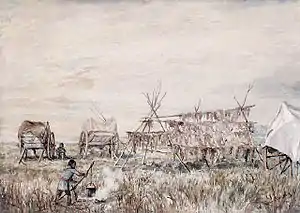
Converting the buffalo into bags of pemmican the Métis would bring them north to trade at the North West Company posts. After the North West Company was absorbed by the Hudson's Bay Company most of the pemmican was sold to the Hudson's Bay Company at Red River.
The pemmican, which forms the staple article of produce from the summer hunt, is a species of food peculiar to Rupert's Land. It is composed of buffalo meat, dried and pounded fine, and mixed with an amount of tallow or buffalo fat equal to itself in bulk. The tallow having been boiled, is poured hot from the caldron into an oblong bag, manufactured from the buffalo hide, into which the pounded meat has previously been placed. The contents are then stirred together until they have been thoroughly well mixed. When full, the bag is sewed up and laid in store. Each bag when full weighs one hundred pounds. It is calculated that, on an average, the carcass of each buffalo will yield enough pemmican to fill one bag.
— Red river by Joseph James Hargrave[20]
The smaller buffalo cow was the main target of the hunt.[39] A buffalo cow, weighing about 900 pounds (410 kg), will yield 272 pounds (123 kg) of meat or 54 pounds (24 kg) to 68 pounds (31 kg) of dried meat. A bull buffalo, weighing 2,000 pounds (910 kg), will yield 550 pounds (250 kg) of meat or between 110 pounds (50 kg) to 137 pounds (62 kg) of dried meat.[40] It takes between 4 pounds (1.8 kg) or 5 pounds (2.3 kg) of meat to produce 1 pound (0.45 kg) of dried meat.[41] A bag of pemmican or a taureau (lit. 'a bull') weighed between 90 pounds (41 kg) to 100 pounds (45 kg)[42] and contained between 45 pounds (20 kg) to 50 pounds (23 kg) of dried pounded meat.[39] These bags of taureaux (lit. 'bulls') when mixed with fat from the udder were known as taureaux fins, when mixed with bone marrow as taureaux grand and when mixed with berries as taureaux à grains.[42]
The product of 1,776 buffalo cows on one autumn hunt in 1845, which 55 hunters and their families with 213 carts took part, was 228 bags of pemmican (pimikchigan) each (90 pounds (41 kg)), 1213 bales of dried meat (viande sèche) each 60 pounds (27 kg) to 70 pounds (32 kg), 166 sacks of tallow (boskoyas) each 200 pounds (91 kg) and 556 bladders of marrow each 12 pounds (5.4 kg).[39]:110
The Hudson's Bay Company depended on the products of the buffalo hunts well into the 1870s. Samuel MacKenzie, the factor of Île-à-la-Crosse, ordered provisions for the passing brigades in 1871. The list included 240 bags of common pemmican (90 pounds (41 kg) each), 8 bags of fine pemmican (45 pounds (20 kg) each), 10 bags of hard grease (100 pounds (45 kg) each) and 1 bag of soft grease (100 pounds (45 kg)) for the Île-à-la-Crosse Post and an additional 29 bags of common pemmican (90 pounds (41 kg)), 1 bag of fine pemmican (90 pounds (41 kg)) and 1 bag of hard grease (100 pounds (45 kg)) was ordered for the Portage La Loche Post.[43]
For these people on the edge of the prairie the pemmican trade was as important a source of trade goods as was the beaver trade for the Indians further north. This trade was a major factor in the emergence of a distinct Métis society. Packs of pemmican would be shipped north and stored at the major fur posts: Fort Alexander, Cumberland House, Île-à-la-Crosse, Fort Garry, Norway House, and Edmonton House. So important was pemmican that, in 1814, governor Miles Macdonell nearly started a war (Pemmican War) with the Métis when he passed the short-lived Pemmican Proclamation, which forbade the export of pemmican from the Red River Colony.[44]
Buffalo robe trade
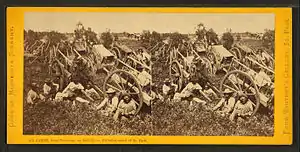

The winter hunts from Red River began in the early 19th century when the population included less than 200 Scottish and Irish settlers, about 100 De Meurons soldiers and a growing number of French voyageurs, descendants of North West Company employees now freemen, and their families. Most spent the winters in Pembina hunting buffalo.[14]:348–349
In 1823 Pembina was found to be just south of the Canada–United States border and in 1844 Norman Kittson opened a successful trading post at Pembina in competition with the Hudson's Bay Company at Red River. By 1849 the Hudson's Bay Company had lost its fur trade monopoly (the result of the Sayer Trial) and the Métis could now freely sell their furs.[25] As the price of buffalo robes increased so did the number of carts heading south from Pembina to St. Paul, Minnesota each year: from 6 carts in 1844 to 400 carts in 1855, 600 to 800 carts in 1858 and 2,500 carts in 1869. Most of this freight was in buffalo robes (25,000 in 1865 alone).[45]
A buffalo robe is a cured buffalo hide, with the hair left on. Only hides taken in the winter hunts between November and March when the furs are in their prime were suitable for buffalo robes.[46] The summer hides had little value to traders and neither were the hides of bulls.[25][46]
Hivernants settlements
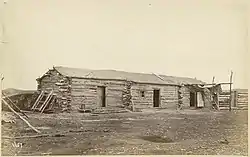
To exploit the demand for buffalo robes many more Métis would spend the winter on the prairie. From the 1840s to the 1870s Métis hivernants hunting camps were established[25] at Turtle Mountain, on the Souris River,[47] Riding Mountain, Wood Mountain,[48] on the Assiniboine, in the Qu'Appelle valley,[49] on the North and South Saskatchewan rivers, in the Cyprus Hills,[48] on the Battle River, on the Red Deer River, and in Montana.[25][50]
New permanent settlements were also founded. They were similar to the settlements of the Red River set on river lots. They also organised their own summer, autumn and winter hunts. St. Albert, established in 1861 by Father Lacombe,[51] became the main staging area for the French Métis buffalo hunters of the Fort Edmonton area including the missions of Lac la Biche and Lac St. Anne. From 300 people in 1864 St. Albert grew to 1,000 in 1870.[52] English Métis from the Victoria settlement northeast of St. Albert also organised hunts.[53] In Saskatchewan Gabriel Dumont was the leader of the hunt for his group of 200 hunters living in the Southbranch settlements on the South Saskatchewan River from 1863 to the end of the buffalo hunts.[54]
The St. Albert fall hunt of 1872 found the majority of the hunters still on the prairies experiencing an October blizzard. They found refuge on Buffalo Lake (Lac du boeuf) where they spent the winter. Buffalo Lake and the Red Deer River valley nearby would become an hivernant settlement[55] with over 80 cabins frequented by both the hunting groups of St. Albert and the Southbranch Settlements. The last of the hunts in 1877 and 1878 were failures and Buffalo Lake, perhaps the largest of the hivernants settlements, was abandoned.[2][56]
Buffalo herds
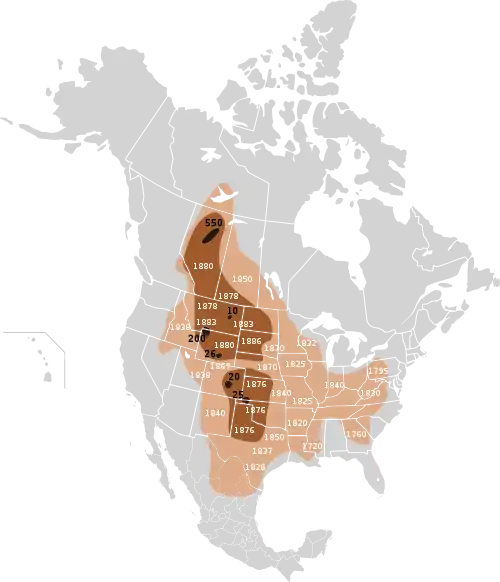
There were two great herds hunted by the hunters of Red River, those of the Grand Coteau du Missouri and the Red River of the North and those of the Saskatchewan River. Other great herds existed south of the Missouri River.[57]
The great western herds winter between the south and the north branches of the Saskatchewan, south of the Touchwood Hills, and beyond the north Saskatchewan in the valley of the Athabasca; They cross the South Branch in June or July, visit the prairies on the south side of the Touchwood Hill range, and cross the Qu'appelle valley anywhere between the Elbow of the South Branch and a few miles west of Fort Ellice on the Assiniboine. They then strike for the Grand Coteau de Missouri, and their eastern flank often approaches the Red River herds coming north from the Grand Coteau. They then proceed across the Missouri up the Yellow Stone, and return to the Saskatchewan and Athabaska as winter approaches, by the flanks of the Rocky Mountains.
— Henry Youle Hind 1860[57]
The Coteau du Missouri, or Missouri Plateau, is a plateau that stretches along the eastern side of the valley of the Missouri River in central North Dakota and north-central South Dakota in the United States and extends into Saskatchewan and Alberta in Canada. The Coteau du Missouri can also refer to a line of rolling hills on the eastern edge of the Missouri Plateau.[58][59][60]
References
- Macdougall, Brenda; St-Onge, Nicole (2013). "Rooted in mobility: Métis buffalo-hunting brigades". Manitoba History. 71 (21).
- John Elgin Foster; Dick Harrison; I. S. MacLaren (1 January 1992). Buffalo. University of Alberta. pp. 67–75. ISBN 978-0-88864-237-0.
- Ens, Gerhard (1996). Homeland to Hinterland: The Changing Worlds of the Red River Metis in the Nineteenth Century. Toronto: University of Toronto Press. p. 12.
- Gaudry, Adam (2014). "Kaa-tipeyimishoyaahk - 'We Are Those Who Own Ourselves': A Political History of Métis Self-Determination in the North-West, 1830-1870". Doctoral Dissertation: 77.
- Gaudry, Adam (2014). "Kaa-tipeyimishoyaahk - 'We Are Those Who Own Ourselves': A Political History of Métis Self-Determination in the North-West, 1830-1870 (Doctoral Dissertation)". ProQuest Dissertations and Theses.
- "Michif Dictionary". The Virtual Museum of Métis History and Culture (in English and Michif). Translated by Fleury, Norman. Gabriel Dumont Institute of Native Studies and Applied Research. Retrieved 10 August 2020.CS1 maint: unrecognized language (link)
- de Champlain, Samuel (1929). Biggar, HP; Cameron, J Home (eds.). The Works of Samuel de Champlain. Publications of the Champlain Society (in English and French). 3. Translated by Langton, HH; Ganong, William F. Toronto: Champlain Society. p. 105.
- The American Heritage Dictionary of the English Language (5 ed.). Houghton Mifflin Harcourt Publishing Company. 2020. Retrieved 10 August 2020.
- Macdougall, Brenda; St-Onge, Nicole (2013). "Rooted in mobility: Metis buffalo-hunting brigades". Manitoba History. 71 (21): 23.
- Ens, Gerhard (1996). Homeland to Hinterland: The Changing Worlds of the Red River Metis in the Nineteenth Century. Toronto: University of Toronto Press.
- Ross, Alexander (1856). The Red River Settlement: Its Rise, Progress and Present State. London: Smith, Elder,-Ross and Haines.
- Gaudry, Adam (2014). "Kaa-tipeyimishoyaahk - 'We Are Those Who Own Ourselves': A Political History of Métis Self-Determination in the North-West, 1830-1870 (Doctoral Dissertation)". ProQuest Dissertations and Theses.
- John McLean (1849). Notes of a Twenty-five Years' Service in the Hudson's Bay Territory. Richard Bentley. pp. 297–302. Retrieved 2014-04-10.
- George Bryce. The Remarkable History of the Hudson's Bay Company ... Nabu Press. ISBN 978-1-277-72735-7. Retrieved 2014-04-10.
- David G. McCrady (1 November 2009). Living with Strangers: The Nineteenth-Century Sioux and the Canadian-American Borderlands. University of Toronto Press. p. 20. ISBN 978-1-4426-0990-7.
- "Buffalo Hunt". Louis Riel Institute. Retrieved 2013-12-23.
- Harper, J. Russell (1972). "Kane, Paul". In Hayne, David (ed.). Dictionary of Canadian Biography. X (1871–1880) (online ed.). University of Toronto Press. Retrieved 2013-12-29.
- William Hypolitus Keating (1824). Narrative of an expedition to the source of St. Peter's river ... &c., performed in ... 1823. p. 44. Retrieved 2014-04-10.
- "Metis Culture: A description and discussion of Metis pad saddles. Illustrations of pad saddles". Lawrence J. Barkwell. Retrieved 2014-02-08.
- Joseph James Hargrave (1871), Red River (Red river. ed.), Montreal: Printed for the author by J. Lovell, p. 168, OCLC 5035707, retrieved 2014-04-10
- "Wilkie, Jean Baptiste". Barkwell, Lawrence J. (Louis Riel Institute). Retrieved 2014-01-07.
- Olive Patricia Dickason (1992). Canada's First Nations: A History of Founding Peoples from Earliest Times. University of Oklahoma Press. p. 294. ISBN 978-0-8061-2439-1. Retrieved 2014-04-10.
- "Report of exploration of a route for the Pacific railroad, near the 47th and 49th parallels, from St. Paul to Puget sound. xii, 599, xv pp. fold. maps. cm.(Stevens, Isaac Ingalls)". Retrieved 2014-01-05.
- "Urbain Delorme - The Rich Man of the Prairies by Lorraine Freeman". Metis Culture &Heritage Resource Centre Inc. Retrieved 2014-01-16.
- John Welsted (1 January 1996). The Geography of Manitoba: Its Land and Its People. Univ. of Manitoba Press. p. 90. ISBN 978-0-88755-375-2.
- Woodcock, George (1985). "Grant, Cuthbert (d. 1854)". In Halpenny, Francess G (ed.). Dictionary of Canadian Biography. VIII (1851–1860) (online ed.). University of Toronto Press. Retrieved 2014-01-12.
- "The Battle at the Grand Coteau: July 13 and 14, 1851". Manitoba Historical Society by William Morton. Retrieved 2013-10-04.
- Barkwell, Lawrence J. "Jean Baptiste "Che-ma-na" Falcon. (b.1826)". Retrieved 2014-01-05.
- "Battle of Grand Coteau: Letter by Father Lafleche". Published by Lawrence J. Barkwell. Retrieved 2013-10-04.
- "Battle of Grand Coteau-North Dakota: 12-14 July 1851". The Loyal Edmonton Regiment Military Museum. Archived from the original on 28 December 2013. Retrieved 2013-12-23.
- "The Métis – Memorable Events and Memorable Personalities" (PDF). George & Terry Goulet. FabJob Calgary. 2006. Retrieved 2013-12-27.
- Christopher Adams; Ian Peach; Gregg Dahl (14 August 2013). Metis in Canada: History, Identity, Law and Politics. University of Alberta. p. 347. ISBN 978-0-88864-640-8.
- Macleod, Roderick C. (1994). "Dumont, Gabriel". In Cook, Ramsay; Hamelin, Jean (eds.). Dictionary of Canadian Biography. XIII (1901–1910) (online ed.). University of Toronto Press. Retrieved 2014-01-06.
- Metis in Canada: History, Identity, Law and Politics. University of Alberta. 14 August 2013. p. 337. ISBN 978-0-88864-718-4.
- Woodcock, George (1975). Gabriel Dumont: the Métis chief and his lost world. Edmonton: Hurtig. p. 98. ISBN 9780888300959.
- Erasmus, Peter; Thompson, Henry (1976). Buffalo days and nights. Calgary: Glenbow-Alberta Institute. p. 229.
- Woodcock, George (1975). Gabriel Dumont: the Métis chief and his lost world. Edmonton: Hurtig. p. 76. ISBN 9780888300959.
- Drake, Karen; Gaudry, Adam (2016). ""The lands...belonged to them, once by the Indiantitle, twice for having defended them...and thricefor having built and lived on them": The Law andPolitics of Métis Title". Osgoode Hall Law Journal. 54 (1): 1–52. Retrieved 10 August 2020.
- Henry Rowe Schoolcraft (1854). Historical and Statistical Information, Respecting the History, Condition and Prospects of the Indian Tribes of the United States: Coll. and Prepared Under the Direction of the Bureau of Indian Affairs Per Act of Congress of March 3rd 1847. Lippincott, Grambo. p. 105. Retrieved 2014-04-10.
- "HOW MUCH MEAT CAN I EXPECT FROM MY BISON?" (PDF). The Bison Ranch at Coteau Ridge. Retrieved 2014-01-02.
- "Manual on simple methods of meat preservation". FOOD AND AGRICULTURE ORGANIZATION OF THE UNITED NATIONS Rome, 1990. Retrieved 2014-01-02.
- "Pemmican by Lawrence J. Barkwell". Retrieved 2013-01-24.
- "History of La Loche (The Portage-HBC letters)". Retrieved 2014-01-04.
- Derek Hayes (2006). Historical Atlas of Canada: Canada's History Illustrated with Original Maps. Douglas & McIntyre. pp. 178–. ISBN 978-1-55365-077-5. Retrieved 2014-04-10.
- R. Douglas Francis; Howard Palmer (1 January 1992). The Prairie West: Historical Readings. University of Alberta. pp. 139–149. ISBN 978-0-88864-227-1.
- William Waterston (1863). A Cyclopaedia of Commerce, Mercantile Law, Finance, Commercial Geography, and Navigation. H.G. Bohn. pp. 142–144. Retrieved 2014-04-10.
- "Métis Wintering Communities". Turtle Mountain–Souris Plains Heritage Association. Retrieved 2014-01-16.
- "FRENCH AND MÉTIS SETTLEMENTS". Encyclopedia of Saskatchewan. Canadian Plains Research Center, University of Regina. 2006. Archived from the original on 2013-11-09. Retrieved 2014-01-16.
- "Cypress hills". Encyclopedia of Saskatchewan. Canadian Plains Research Center, University of Regina. 2006. Retrieved 2014-01-16.
- Arnette, Travis R. "Where the Buffalo Roam: Migration of the French Red River Metis to Lewistown, Montana" (PDF). Montana State University. Archived from the original (PDF) on 2013-06-01. Retrieved 2015-05-14.
- "The Métis". Alberta Culture. Retrieved 2014-01-14.
- "St. Albert Settlement". Alberta Culture. Government of Alberta. 1995–2012. Retrieved 2014-01-16.
- Richard Cole Harris; Geoffrey J. Matthews; R. Louis Gentilcore (1987). Historical Atlas of Canada: The land transformed, 1800-1891. University of Toronto Press. p. 92. ISBN 978-0-8020-3447-2. Retrieved 2014-04-10.
- "The Bison Hunt" (PDF). Virtual Museum. Retrieved 2014-01-05.
- "The Metis Homeland: Its Settlements and Communities (map of Buffalo Lake)". Retrieved 2013-02-13.
- "The Buffalo Hunt Public Artwork and Park". St. Albert Historical Society. Retrieved 2014-01-16.
- Henry Youle Hind (1860). Narrative of the Canadian Red River Exploring Expedition of 1857: And of the Assinniboine and Saskatchewan Exploring Expedition of 1858. Longman, Green, Longman and Roberts. pp. 103–. Retrieved 2014-04-10.
- Shjeflo, Jelmer B. "Evapotranspiration and the Water Budget of Prairie Potholes in North Dakota". Archived from the original on 2012-04-26. Retrieved 2012-12-24.
- John C. Hudson (8 February 2002). Across This Land: A Regional Geography of the United States and Canada. JHU Press. pp. 296–. ISBN 978-0-8018-6567-1.
- Penner, Lynden, "Missouri Coteau", The Encyclopedia of Saskatchewan, retrieved 2007-05-16
External links
- Bison Hunting http://www.metismuseum.ca/media/document.php/00716.VM%20-%20Bison%20Hunting.pdf
- Metis Bison Hunters (Canadian Museum of Civilization)
- Paul Kane (Artist as Buffalo hunter)
- The Bison Hunt (The Many Uses of the Bison)
- Songs of Old Manitoba (2) Pierre Falcon: The Buffalo Hunt and The Dickson Song
- Image of Red River Camp in 1853
- John Mix Stanley (American, 1814–1872), Camp of the Red River Hunters, 1857
- Red River Settlement by Paul Kane c. 1848
- Metis camp at night, with Red River carts in circle. 1859